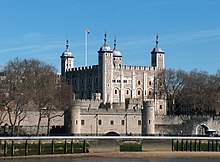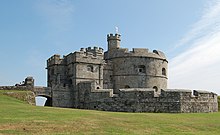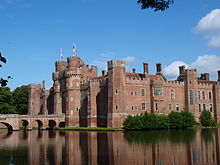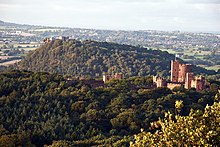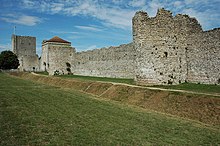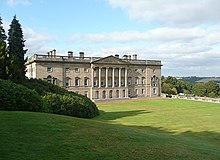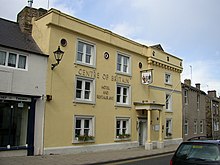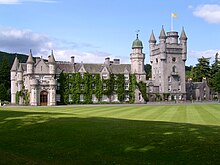ENGLISH CASTLES
The Tower of London
A castle is a type of fortified structure, developed in Europe during the Middle Ages. The first castles appeared in France in the 10th century,[3] and in England during the 11th century. A few castles are known to have been built in England before the Normans invaded in 1066;[4] a great many were built in the years following, the principal mechanism by means of which the Normans were able to consolidate their control over the country.[5] Whilst a few important castles, such as the White Tower in the Tower of London, were built of stone, most early castles were motte-and-bailey castles of earthwork and timber, which could be constructed quickly. Some were later rebuilt in stone,[6] but there are a great many castle sites in England where all that is visible today are traces of earthworks.[7]
Castles continued to be built in England for several hundred years, reaching a peak of military sophistication in the late 13th century.[8] The two principal elements in their construction were the great tower or keep, such as the White Tower, and the fortified enclosure, such as is provided by the outer wall of the Tower of London. During the 14th century, largely as a result of the decline of feudalism,[9] the construction of strong castles began to decline, in favour of more lightly fortified structures often described as fortified manor houses.[10] In the far north of England, where conditions remained unsettled, fortified buildings continued to be built as late as the 16th century, not only by the rich and powerful but by any with adequate means, as defence not against great armies, but against the notorious Border Reivers. Many took the form of the pele tower, a smaller, more modest version of the castle keep,[11] and many of these still survive, often incorporated in later buildings.
Pendennis Castle, Cornwall: a 16th-century Henrician Castle
Castles differed from earlier fortifications in that they were generally private fortified residences. Typically, a castle was the residence of a feudal lord, providing the owner with a secure base from which to control his lands,[12] and also a symbol of wealth and power. Earlier fortified structures, such as the Saxon burh or the Iron Age hill fort, provided public or communal defences,[13] as did medieval town or city walls. The many Roman forts of which ruins survive in Britain differed in being wholly military in nature - they were camps or strongholds of the Roman army. The Romans also built town or city walls in England, which can still be seen, for instance at Silchester.
By the 16th century the role of fortifications had changed once more with the development of artillery capable of breaching even thick stone walls. In the reign of Henry VIII, fears of invasion[14] led to the building of a series of new fortresses along the south coast of England,[15] known as the Device Forts or Henrician Castles. These were designed to use and to defend against artillery, and since they were not private residences, but national fortifications, they do not possess what architectural historians have come to see as the defining characteristics of a castle.[16] Nonetheless they are visibly castle-like, being compact, with battlemented walls, squat turrets and sometimes a keep; and they were the last generation of fortresses in England to be known as castles, long before architectural historians began to argue that they should not be.[17] One of them, Pendennis Castle, was one of the last Royalist strongholds to fall to the Parliamentarians during the English Civil War—starvation forcing surrender after a siege of five months.[18]
Herstmonceux Castle, East Sussex
As the role of the castle as fortress declined in the later medieval period, its role as a residence increasingly became the more important. Castles such as Herstmonceux were built with fortifications seemingly designed more for show than for strength,[19] implying a further evolution in the role and concept of the castle, becoming less a means of enforcing power but instead a symbol of its possession, a castle becoming a grand residence proclaiming the status of its owner. Once fortifications had become altogether redundant, it became increasingly rare in England for new buildings to be described as castles, in contrast to France, where country houses continued to be known as châteaux.
Once no longer needed as fortresses, castles — if they were not abandoned — were, over the centuries, adapted and modernised to make them more suitable for continued use as residences:[20] large windows were inserted in defensive walls, as at Lumley; outer walls were demolished or lowered to open up views from within, as at Raby; new residential ranges were built to improve and extend accommodation, as at Windsor. Some castles were restored after falling into ruin, like Bamburgh;[21] others, like Belvoir, were demolished and rebuilt, retaining little or none of the original structure.[22] In the 18th and 19th centuries especially, many castles underwent "improvements" by architects such as Anthony Salvin, and in this period a fashion developed for entirely new houses to be built in the style of castles, and to be known as castles.[23][24] Amongst these was Peckforton Castle, built by Salvin: a building so authentic in its recreation of a medieval castle that it has been described as possibly the last serious fortified home built in Britain.[25]
Peckforton Castle, Cheshire, with Beeston Castle in the distance
Scope and exclusions
No list of castles in England is ever likely to be complete, because there will never be complete agreement in every case as to whether the remains of a building are those of a castle, whether a given place is the site of a castle, or whether a surviving building should be considered to be a castle.[26]
Perhaps because the castle has become the most familiar type of fortification, many sites of fortifications earlier than the 10th century have become known as castles. Most of these are Iron Age hill forts. Amongst the best known are Abbotsbury Castle, Barbury Castle, Bratton Castle, Cadbury Castle, Castle Dore, Chûn Castle, Liddington Castle, Maen Castle, Maiden Castle and Uffington Castle,[27] whilst many more appear in the List of hill forts in England. Others, such as Melandra Castle, Reculver Castle, Richborough Castle and Whitley Castle, are Roman forts, whilst Daw's Castle is a Saxon burh.[27] None of these is included in the present list unless it is also the site of a medieval castle, as is the case with, for instance, Portchester Castle, where an imposing castle was built within the surviving walls of the Roman fort.[28]
Portchester Castle, Hampshire: Roman walls and medieval keep
Nor are all medieval fortified sites included in the present list. The remains of town and city walls are excluded — most of these appear in the List of town walls in England and Wales. Also excluded are churches with defensive towers, such as Ancroft, Burgh by Sands, Edlingham, Garway, Great Salkeld and Newton Arlosh, as well as other fortified ecclesiastical sites such as Alnwick Abbey, Battle Abbey, Thornton Abbey, Wetheral Priory, Whalley Abbey and St Mary's Abbey, York.[29] Some of the pele towers of Northern England are included, but the more modest fortified buildings known as bastles are not, though the distinction between them is not always altogether clear. Amongst fortified manor houses, those given the title of castle are included, whilst many others were more lightly fortified and are excluded. Amongst these are Baddesley Clinton, Cowdray House, Farnhill Hall, Hipswell Hall, Ightham Mote, Little Wenham Hall, Markenfield Hall and Walburn Hall.[29]
The list includes pele towers that became known as castles, or preserve a castle-like aspect. Many others, or their remains, survive much altered—incorporated in later country houses or farmhouses, and are excluded. Amongst these are: Aske Hall, Biddlestone RC Chapel, Bolling Hall, Bolton Old Hall, Boltongate Rectory, Causey Park House, Clennell Hall, Cliburn Hall, Corbridge Low Hall, Cowmire Hall, Craster Arms (Beadnell), Croglin Old Pele, Denton Hall, Dovenby Hall, Dunstan Hall, East Shaftoe Hall, Godmond Hall, Great Salkeld Rectory, Hardrigg Hall, Hepscott Hall, Hetton Hall, Hollin Hall, Hutton Hall (Penrith), Irton Hall, Johnby Hall, Killington Hall, Kirkoswald College, Levens Hall, Little Harle Tower, Nether Hall, Netherby Hall, Ormside Hall, Pockerley Pele, Preston Patrick Hall, Randalholme Hall, Rock Hall, Rudchester Hall, Sella Park, Selside Hall, Skelsmergh Hall, Smardale Hall, Thistlewood Farmhouse, Warnell Hall, Weetwood Hall and Witton Tower.[29]
In the post-medieval period, the distinction between true castles and later mock castles is blurred by the extent to which medieval castles were adapted and rebuilt. At Greystoke a new castle was built incorporating a medieval pele tower;[30] at Thurland a new castle was built from the ruins of the old;[31] at Belvoir the old castle was demolished and a new one built.[22] The building of mock castles might be seen as the logical conclusion of a process already apparent in castles such as Herstmonceux or Tattershall, where the castle-like aspect of the building was becoming more for show than for strength.[19]
Wentworth Castle: not a castle but a country house
Amongst post-medieval buildings in England that are known as castles, a few, such as Peckforton Castle, closely resemble medieval castles. Many others, such as Clearwell Castle, have some castle-like features, and some, like Mereworth Castle, bear no resemblance whatsoever to a castle. The list excludes buildings that neither look like castles, nor incorporate the remains of castles. Amongst these are Bolebroke Castle, Bovey Castle, Bruce Castle, Castle Ashby, Castle Howard, Clifton Castle, Highclere Castle, Mereworth Castle, New Wardour Castle, Sherborne Castle, Wentworth Castle, and Wisbech Castle.[32] Many other buildings with some castle-like features are also excluded. Amongst these are Acton Castle, Allerton Castle, Augill Castle, Avon Castle, Bell's Castle, Bolesworth Castle, Bude Castle, Castle Eden Castle, Castle Goring, Cave Castle, Clearwell Castle, Cliffe Castle, Coates Castle, Creech Castle, Droskyn Castle, Edmond Castle, Enmore Castle, Ewell Castle, Farleigh Castle, Farley Castle, Fillingham Castle, Hatherop Castle, Headingley Castle, Highcliffe Castle, Hilfield Castle, Kenwith Castle, Kirby Knowle Castle, Knepp Castle, Luscombe Castle, Midford Castle, Mulgrave Castle, Otterburn Tower, Pentillie Castle, Reeve Castle, Ryde Castle, St. Clare Castle, Sibdon Castle, Sneaton Castle, Stanhope Castle, Studley Castle, Swinton Castle, The Citadel (Weston-under-Redcastle), Tregenna Castle, Vanbrugh Castle, Wadhurst Castle, Wattisham Castle, Whitehaven Castle, Whitstable Castle, Willersley Castle, and Willsbridge Castle.[32] Amongst those that have been demolished is Steephill Castle.
Artificial ruins and follies, often built as memorials or landscape features, are also excluded. Amongst these are Appley Tower, Black Castle, Bladon Castle, Blaise Castle, Bollitree Castle, Boston Castle, Braylsham Castle, Broadway Tower, Carr Hall Castle, Castlebourne, Clent Castle, Clopton Tower, Dinton Castle, Doyden Castle, Dunstall Castle, Durlston Castle, Fort Putnam, Hadlow Castle, Castle in Hagley Park Lawrence Castle, Long's Park Castle, Mow Cop Castle, Mowbray Castle, Pirton Castle, Radford Castle, Radway Tower, Ragged Castle (Badminton), Rivington Castle, Rodborough Fort, Ross Castle, Rothley Castle, Roundhay Castle, Sebergham Castle, Severndroog Castle, Shaldon Castle, Sham Castle (Bath), Sledmere Castle, Speedwell Castle, Stainborough Castle, Starlight Castle, Stowe Castle, Strattenborough Castle, Sundorne Castle, Toll House (Clevedon) and Wyke Castle.[32] Finally, the 16th-century Henrician Castles, whose design was closely inspired by medieval castles, are included, but later military fortifications—with just a few exceptions—are not.
Red Lion Tower, Haltwhistle
However carefully the criteria for including a building or site on this list are set out, borderline cases are inevitable. Many buildings known to incorporate northern pele towers in their fabric, but are no longer castle-like—such as the Red Lion Tower in Haltwhistle—have been excluded. On the other hand Corby Castle, in which a pele tower survives wholly encased in a later building,[33] is included because it is known as a castle, and by implication continued to fulfil the role of one, at least in part. Kimbolton Castle is included as the site of a medieval castle, and because the present mansion has a castellated aspect in deference to the medieval castle it replaced.
Caerlaverock Castle, a moated triangular castle, first built in the thirteenth century
Scottish castles are buildings that combine fortifications and residence, built within the borders of modern Scotland. Castles arrived in Scotland with the introduction of feudalism in the twelfth century. Initially these were wooden motte-and-bailey constructions, but many were replaced by stone castles with a high curtain wall. During the Wars of Independence, Robert the Bruce pursued a policy of castle slighting. In the late Middle Ages new castles were built, some on a grander scale as "livery and maintenance" castles that could support a large garrison. Gunpowder weaponry led to the use of gun ports, platforms to mount guns and walls adapted to resist bombardment.
Many of the late Medieval castles built in the borders were in the form of tower houses, smaller pele towers or simpler bastle houses. From the fifteenth century there was a phase of Renaissance palace building, which restructured them as castle-type palaces, beginning at Linlithgow. Elements of Medieval castles, royal palaces and tower houses were used in the construction of Scots baronial estate houses, which were built largely for comfort, but with a castle-like appearance. In the seventeenth and eighteenth centuries the military significance of castles declined, but they increasingly became tourist attractions. Elements of the Scots Baronial style would be revived from the late eighteenth century and the trend would be confirmed in popularity by the rebuilding of Balmoral Castle in the nineteenth century and its adoption as a retreat by Queen Victoria. In the twentieth century there were only isolated examples of new castle-influenced houses. Many tower houses were renovated, and many castles were taken over by the National Trust for Scotland or Historic Scotland and are open to the public.
Middle Ages
The Bass of Inverurie in Scotland, a large motte and bailey castle built in the mid-twelfth century
Castles, in the sense of a fortified residence of a lord or noble, arrived in Scotland as a consequence of the centralising of royal authority in the twelfth century.[1] Prior to the 1120s there is very little evidence of castles having existed in Scotland, which had remained less politically centralised than in England with the north still ruled by the kings of Norway.[2] David I of Scotland (r. 1124–53) spent time at the court of Henry I of England, becoming Earl of Huntingdon, and returned to Scotland with the intention of extending royal power across the country and modernising Scotland's military technology, including the introduction of castles.[3] The Scottish king encouraged Norman and French nobles to settle in Scotland, introducing a feudal mode of landholding and the use of castles as a way of controlling the contested Scottish Lowlands.[1][2] Historian Lise Hull has suggested that the creation of castles in Scotland was "less to do with conquest" and more to do with "establishing a governing system".[4]
These were primarily wooden motte-and-bailey constructions, of a raised mount or motte, surmounted by a wooden tower and a larger adjacent enclosure or bailey, both usually surrounded by a fosse (a ditch) and palisade, and connected by a wooden bridge.[5] They varied in size from the very large, such as the Bass of Inverurie, to more modest designs like Balmaclellan.[6] In England many of these constructions were converted into stone "keep-and-bailey" castles in the twelfth century, but in Scotland most of those that were in continued occupation became stone castles of "enceinte" from the thirteenth century, with a high embattled curtain wall.[5] The need for thick and high walls for defence forced the use of economic building methods, often continuing the Scottish tradition of dry-stone rubble building, which were then covered with a lime render, or harled for weatherproofing and a uniform appearance.[7] In addition to the baronial castles there were royal castles, often larger and providing defence, lodging for the itinerant Scottish court and a local administrative centre. By 1200 these included fortifications at Ayr and Berwick.[8] In Scotland Alexander II (r. 1198–1249) and Alexander III (1241–86) undertook a number of castle building projects in the modern style. Alexander III's early death sparked conflict in Scotland and English intervention under Edward I in 1296. The resulting Wars of Independence brought this phase of castle building to an end and began a new phase of siege warfare.[9][10]
Dunstaffnage Castle, one of the oldest surviving "castles of enceinte", mostly dating from the thirteenth century
The first recorded siege in Scotland was the 1230 siege of Rothesay Castle where the besieging Norwegians were able to break down the relatively weak stone walls with axes after only three days.[10] When Edward I invaded Scotland he brought with him the siege capabilities that had evolved south of the border, resulting in the rapid fall of major castles. Edinburgh Castle fell within three days, and Roxburgh, Jedburgh, Dunbar, Stirling, Lanark and Dumbarton castles all surrendered to the English king.[11] Subsequent English sieges, such as the attacks on Bothwell and Stirling, again used considerable resources including giant siege engines and extensive teams of miners and masons.[12] As a result Robert the Bruce (r. 1306–29) adopted a policy of castle destruction, rather than allow fortresses to be easily retaken and then held by the English, beginning with his own castles at Ayr and Dumfries,[13] and including Roxburgh and Edinburgh.[14] After the Wars of Independence, new castles began to be built, often on a grander scale as "livery and maintenance" castles, to house retained troops, like Tantallon, Lothian and Doune near Stirling, rebuilt for Robert Stewart, Duke of Albany in the fourteenth century.[5]
Early gunpowder weapons were introduced to Scotland by the 1330s.[15] The new technology began to be installed in Scottish castles by the 1380s, beginning with Edinburgh.[16] In the fifteenth century, gunpowder weaponry fundamentally altered the nature of castle architecture. Existing castles were adapted to allow the use of the new weapons by the incorporation of "keyhole" gun ports, platforms to mount guns and walls that were adapted to resist bombardment. Ravenscraig, Kirkcaldy, begun about 1460, is probably the first castle in the British Isles to be built as an artillery fort, incorporating "D-shape" bastions that would better resist cannon fire and on which artillery could be mounted.[17] It also used "letter box" gun-ports,[18] common in mainland Europe, although rarer in England, they rapidly spread across the kingdom. Scotland also led the way in adopting the new caponier design for castle ditches, as constructed at Craignethan Castle.[19]
Tower houses
Main article: Tower houses
Clackmannan Tower, a tower house, originally built in the fourteenth century
The largest number of late Medieval fortifications in Scotland built by nobles, about 800,[20] were of the tower house design.[9][10] Smaller versions of tower houses in southern Scotland were known as peel towers, or pele houses.[21] The defences of tower houses were primarily aimed to provide protection against smaller raiding parties and were not intended to put up significant opposition to an organised military assault. This has led historian Stuart Reid to characterise them as "defensible rather than defensive".[22] They were typically a tall, square, stone-built, crenelated building. They were often also surrounded by a barmkyn or bawn, a walled courtyard designed to hold valuable animals securely, but not necessarily intended for serious defence.[23][24] They were built extensively on both sides of the border with England from the fourteenth century. James IV's (1488–1513) forfeiture of the Lordship of the Isles in 1494 led to an additional burst of tower building across the region.[25][26] A number were also built in Scottish towns.[27]
An option for small landholders and farmers was the bastle house, a form of fortified house that combined the functions of a tower house and a barmkyn. They were usually two-storey houses with the ground floor acting as a byre into which animals could be driven, while the living space on the upper floor could only be reached by a removable ladder. Most are within 30 miles (48 km) of the border and were built around the turn of the sixteenth century.[28]
Renaissance palaces
See also: Renaissance in Scotland
Linlithgow Palace, extensively rebuilt along Renaissance principles from the fifteenth century as a castle-style palace
An extensive building and rebuilding of royal palaces probably began under James III (r. 1460–88) and accelerated under James IV, reaching its peak under James V (r. 1513–42). They used exceptional one-off revenues, such as the forfeiture of key lands, to establish their power across their kingdom in various ways including constructing grander castles by extending and modifying existing fortifications. These works have been seen as directly reflecting the influence of Renaissance styles. Linlithgow was first constructed under James I, under the direction of master of work John de Waltoun and was referred to as a palace, apparently the first use of this term in the country, from 1429. This was extended under James III and began to correspond to a fashionable quadrangular, corner-towered Italian signorial palace of a palatium ad moden castri (a castle-style palace), combining classical symmetry with neo-chivalric imagery and using harling to give them a clean, Italian appearance. There is evidence of Italian masons working for James IV, in whose reign Linlithgow was completed and other palaces were rebuilt with Italianate proportions.[29] According to architectural historian John Dunbar, the results were the "earliest examples of coherent Renaissance design in Britain".[30]
The shift in architectural focus reflected changing political alliances, as James V had formed a close alliance with France during his reign.[31] He encountered the French version of Renaissance building while visiting for his marriage to Madeleine of Valois in 1536 and his second marriage to Mary of Guise may have resulted in longer term connections and influences.[32] Work from his reign largely disregarded the insular style adopted in England under Henry VIII and adopted forms that were recognisably European, beginning with the extensive work at Linlithgow.[33] This was followed by re-buildings at Holyrood, Falkland, Stirling and Edinburgh,[34] described by Roger Maison as "some of the finest examples of Renaissance architecture in Britain".[35]
Much of this castle rebuilding was planned and financed by James Hamilton of Finnart (c. 1495–1540), in addition to his work at Blackness Castle, Rothesay Castle, the house at Crawfordjohn, the "New Inn" in the St Andrews Cathedral Priory and the lodging at Balmerino Abbey for the ailing Queen Madeleine.[36] Rather than slavishly copying continental forms, most Scottish architecture incorporated elements of these styles into traditional local patterns,[34] adapting them to Scottish idioms and materials (particularly stone and harl).[37] Similar themes can be seen in the private houses of aristocrats, as in Mar's Wark, Stirling (c. 1570) and Crichton Castle, built for the Earl of Bothwell in 1580s.[38]
Sixteenth and seventeenth centuries
Main article: Scots baronial
The sixteenth-century Claypotts Castle, showing many of the features of the Scots Baronial style.
In the period of French intervention in the 1540s and 1550s, at the end of the Rough Wooing, Scotland was given a defended border of a series of earthwork forts and additions to existing castles. These included the erection of single bastions at Edinburgh, Stirling and Dunbar.[39]
The unique style of great private houses in Scotland, later known as Scots baronial, has been located in origin to the period of the 1560s. It kept many of the features of the high walled Medieval castles that had been largely made obsolete by gunpowder weapons and may have been influenced by the French masons brought to Scotland to work on royal palaces. It drew on the tower houses and peel towers,[40] with their parapets, corbels, and bartizans.[41] The new estate houses built from the late sixteenth century by nobles and lairds were primarily built for comfort, not for defence, although they were often called castles. They retained many of these external features which had become associated with nobility, but with a larger ground plan. This was classically a "Z-plan" of a rectangular block with towers, as at Colliston Castle (1583) and Claypotts Castle (1569–88).[40]
Particularly influential was the work of William Wallace, the king's master mason from 1617 until his death in 1631. He worked on the rebuilding of the collapsed North Range of Linlithgow from 1618, Winton House for George Seton, 3rd Earl of Winton and began work on Heriot's Hospital, Edinburgh. He adopted a distinctive style that applied elements of Scottish fortification and Flemish influences to a Renaissance plan like that used at Château d'Ancy-le-Franc. This style can be seen in lord's houses built at Caerlaverlock (1620), Moray House, Edinburgh (1628) and Drumlanrig Castle (1675–89), and was highly influential until the baronial style gave way to the grander English forms associated with Inigo Jones in the later seventeenth century, which were used to produce classically inspired and comfortable country houses.[40]
Decline
Blair Castle, extensively rebuilt in the eighteenth century, it became a popular tourist location
In 1603 James VI of Scotland inherited the crown of England, bringing a period of peace between the two countries. The royal court left for London, and as a result – with the exceptions of occasional visits - building work on royal castles north of the border largely ceased.[42][43] Some castles continued to have modest military utility into the eighteenth century. The royal castles of Edinburgh, Dumbarton and Stirling, along with Dunstaffnage, Dunollie, Blackness and Ruthven Castle, continued in use as practical fortifications.[25][44] Tower houses were being built up until the 1640s. After the Restoration the fortified tower house fell out of fashion, but the weak state of the Scottish economy was such that, while many larger properties were simply abandoned, the more modest castles continued to be used and adapted as houses, rather than rebuilt.[45][46]
In the Bishop's Wars castles that held out for the king against the Covenanters, including Caerlaverock and Threave in 1640, were slighted, with their roofs removed and walls breached to make them uninhabitable. Tantallon was used as a base for Scottish attacks on Oliver Cromwell's advancing army in 1651. As a result it was pounded into submission by the New Model Army's siege train, losing its end towers and ceasing to be a residence from that point.[47] The sequence of Jacobite risings from 1689 threatened the Crown in Scotland, culminating in the rebellion in 1745.[25] Stirling was able to withstand the Jacobite attack in 1745 and the siege of Blair Castle, at the end of the rebellion in 1746, was the final castle siege to occur in the British Isles.[48][49] In the aftermath of the conflict Corgaff and many others castles were used as barracks for the forces sent to garrison the Highlands.[46] Kildrummy, Huntly and Doune were destroyed as a result of their part in the rebellion.[47]
From the late eighteenth century, castles became tourist attractions. Blair Castle was a popular location on account of its landscaped gardens, and Stirling Castle because of its romantic historic connections.[50] Tours became increasingly popular during the nineteenth century, usually starting at Edinburgh and then spending up to two weeks further north, taking advantage of the expanding rail and steamer network.[51] Blair Castle remained popular, but additional castles joined the circuit, with Cawdor Castle becoming popular once the railway line reached north to Fort William.[52] Scottish castle guidebooks became well known for providing long historical accounts of their sites, often drawing on the plots of Romantic novels for the details.[53][54] Sir Walter Scott's novels set in Scotland popularised several northern castles, including Tantallon, which was featured in the poem Marmion (1808).[55]
Gothic revival
See also: Gothic revival
Balmoral Castle, re-built for Queen Victoria in the Scots Baronial style.
In Scotland there was a revival of the castle in the late eighteenth and nineteenth centuries as part of the wider Gothic Revival movement, as new houses were built and existing buildings remodeled in the Gothic and Scots Baronial styles.[56] Inveraray Castle, constructed from 1746 with design input from William Adam, displays the incorporation of turrets and is among the first houses in the revived style. His son Robert Adam's houses in this style included Mellerstain and Wedderburn in Berwickshire and Seton House in East Lothian, but it is most clearly seen at Culzean Castle, Ayrshire, remodelled by Adam from 1777. These were largely conventional Palladian style houses that incorporated some external features of the Scots baronial style.[57]
Important for the adoption of the revival in the early nineteenth century was Abbotsford House, the residence of Walter Scott. Re-built for him from 1816, it became a model for the modern revival of the baronial style. Common features borrowed from sixteenth- and seventeenth-century houses included battlemented gateways, crow-stepped gables, pointed turrets and machicolations. The style was popular across Scotland and was applied to many relatively modest dwellings by architects such as William Burn (1789–1870), David Bryce (1803–76),[58] Edward Blore (1787–1879), Edward Calvert (c. 1847–1914) and Robert Stodart Lorimer (1864–1929) and in urban contexts, including the building of Cockburn Street in Edinburgh (from the 1850s) as well as the National Wallace Monument at Stirling (1859–69).[59] The rebuilding of Balmoral Castle as a baronial palace and its adoption as a royal retreat from 1855–58 confirmed the popularity of the style.[60] Scots Baronial architects frequently "improved" existing castles: Floors Castle was transformed in 1838 by William Playfair who added grand turrets and cupolas.[5] The style spread south and the architect Edward Blore added a Scots Baronial touch to his work at Windsor.[61]
Twentieth century to the present
Eilean Donan was completely rebuilt between 1919 and 1932
The Baronial style peaked towards the end of the nineteenth century, and the building of large houses declined in importance in the twentieth century. It continued to influence the construction of some estate houses, including Skibo Castle, which was rebuilt for industrialist Andrew Carnegie (1899–1903) by Ross and Macbeth. There was a lull in building after the First World War, and social change undermined the construction of rural country houses. Isolated examples of "castles" include houses that combine modern and traditional elements, such as Basil Spence's Broughton Place (1936) and Glenskirlie Castle, Stirlingshire (2007).[62][63]
Restoration of castles began in the early twentieth century, with projects including the renovation of Duart Castle on Mull,[64] and the complete reconstruction of Eilean Donan from a few fragments of masonry.[65] The restoration movement grew after World War II with a fashion for renovating tower houses, including Oliver Hill's restoration of Inchdrewer Castle, near Banff in Aberdeenshire, in 1965.[62] The restoration of tower houses and smaller castles continues, with recent examples including Fenton Tower in Lothian and Ballone Castle near Portmahomack.[64][66] Historic Scotland have launched a "Scottish Castle Initiative" aimed at encouraging private investment in the restoration of Scotland's castles, including a register of potential restoration candidates.[64] Despite these efforts, a number of castles remain on Scotland's Buildings at Risk Register.[67]
Most of Scotland's castles, whether ruined or occupied, remain in private ownership, though many are open to the public at least occasionally. During the twentieth century a number of older castles were transferred into the care of the state, and these are now the responsibility of Historic Scotland, which was created as an agency in 1991. Historic Scotland cares for over 300 properties – all of which are publicly accessible – including around 65 castles.[68][69] These include some of Scotland's most famous castles including Edinburgh and Stirling, as well as numerous tower houses and ruined castles. The National Trust for Scotland (founded 1931) cares for several post-Medieval castles and estate houses, including Culzean and Craigievar that were still in occupation until the twentieth century.[70] The Landmark Trust restores and operates historic buildings as holiday homes, including Saddell Castle and Roslin Castle.[71] Several other castles are in the hands of local government, for example Dudhope Castle in Dundee, and some are maintained by building preservation trusts and other charitable bodies, for example Sauchie Tower, Clackmannanshire
WINDSOR HISTORY
60M
https://www.youtube.com/watch?v=WRNIoXtWEew
SECRETS OF HIGHCLERE CASTLE
60M
https://www.youtube.com/watch?v=i_wviAKjkUM
